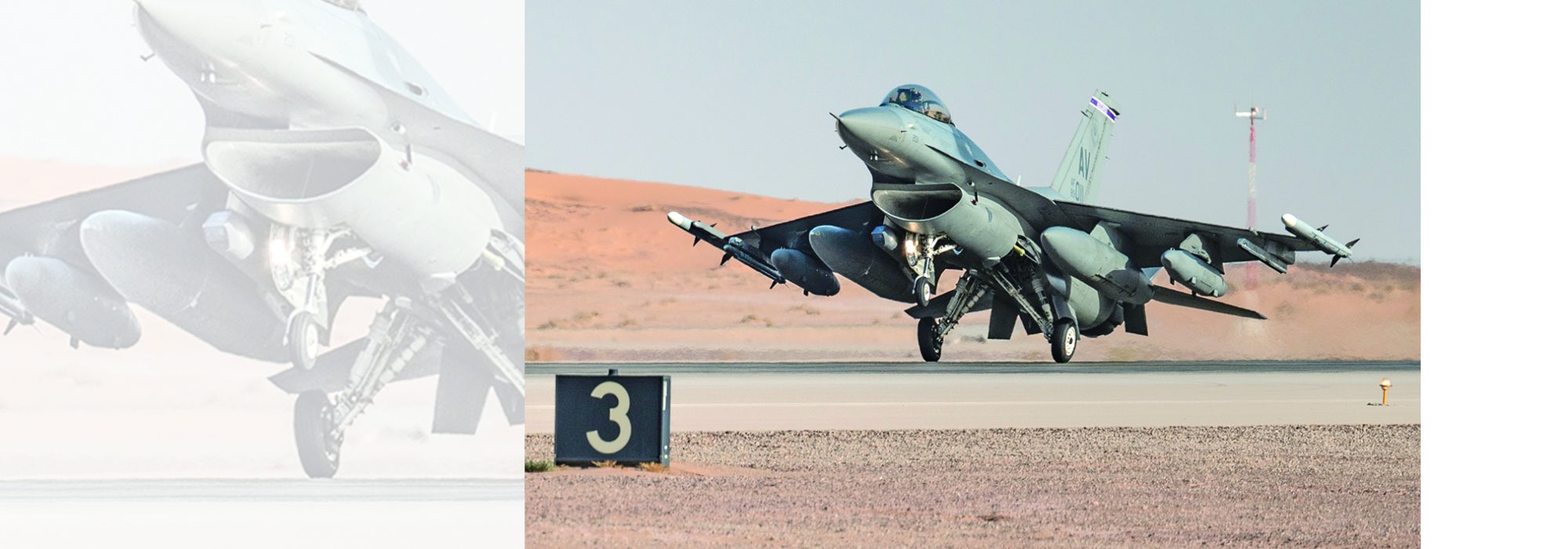Fighters Knock Down Drones Headed for Israel
By Chris Gordon
U.S. Air Force F-15E Strike Eagles and F-16 Fighting Falcons shot down dozens of Iranian drones as they headed toward targets in Israel on April 13, a unique international defensive operation that effectively shut down an Iranian offensive.
F-15E Strike Eagles from the 494th Fighter Squadron and the 335th Fighter Squadron along with F-16s from unidentified units were involved in downing more than 70 Iranian drones, Air & Space Forces Magazine confirmed.
A U.S. Army Patriot battery in Erbil, Iraq, took down a ballistic missile, and the USS Arleigh Burke and USS Carney in the Eastern Mediterranean took down four to six ballistic missiles, officials added. U.S. Navy aircraft also supported the mission.
President Joe Biden personally commended members of the F-15 squadrons “for their exceptional airmanship and skill in defending Israel from an unprecedented aerial attack by Iran,” the White House said.
The Iranian attack totaled more than 100 ballistic missiles, 30 land-attack cruise missiles, and 150 drones, launched from Iran, Iraq, Syria, and Yemen. As many as 100 were airborne at any given moment during the skirmish, an official said.
U.S. and Israeli officials said “99 percent” of the drones and missiles were intercepted, the majority by Israeli defenses. British and French fighters also took down some drones.
“The close cooperation between the U.S. military and the IDF (Israel Defense Forces) has led to the formation of a strong coalition that proved itself last night in the face of Iran’s aerial attack,” the IDF said in an April 14 statement.
With Israel mounting its defense with Arrow 2 and Arrow 3 surface-to-air interceptors and fighter jets, the U.S. coordinated coalition forces from the Combined Air Operations Center at Al Udeid Air Base, Qatar, where Air Forces Central (AFCENT) boss Lt. Gen. Alexus G. Grynkewich was the regional air defense commander. (He has since become the Operations Chief, or J3, on the Joint Staff at the Pentagon).
Biden ordered additional F-15s and destroyers to the region ahead of the attack, saying later that the move helped ensure “nearly all” of the incoming drones and missiles were intercepted.
In an interview with Air & Space Forces Magazine on April 14, Grynkewich declined to discuss Iran’s attack, but did describe how the CAOC typically coordinates air defense.
“We take whatever assets we have that are in theater … under our tactical control or in a direct support role across the joint force and the coalition, and we stitch them together so that we can synchronize the fires and effects when we get into that air defense fight,” Grynkewich said.
“We’re trying to stitch together partners in the region who share a perspective of a threat, share concern of the threats to stability in the region—which primarily emanate from Iran with a large number of ballistic missiles—and be in a position where we’re able to share information, share threat warning,” Grynkewich said. “And the ultimate goal is to get to a much deeper and fuller integration. We’ve made tremendous progress.”
British Prime Minister Rishi Sunak said Royal Air Force jets shot down “a number” of Iranian drones during the barrage. The U.K. Defense Ministry said in a statement that RAF aircraft in the region were prepared to “intercept any airborne attacks within range of our existing missions.” Additional RAF fighter jets and refueling tankers have been deployed for the counter-Islamic State mission in Iraq and Syria, which has also freed up U.S. air assets to focus on intercepting Iranian threats.
“It’s a win for the concept of integrated air and missile defense across the theater,” retired Marine Corps Gen. Kenneth F. McKenzie, the CENTCOM commander from 2019 to 2022, told Air & Space Forces Magazine. “People should draw strong conclusions from what just happened about the efficacy of that approach.”
Other former top Middle East generals agreed.
“One of the big concerns we had was how we were going to share the air picture with the Israelis and then coordinate who was doing what when the shooting started,” added retired Air Force Gen. Jeffrey L. Harrigian, the commander of AFCENT from 2016 to 2018. “Based on the results, it sounds like it was pretty good coordination.”
CENTCOM’s commander from 2016 to 2019, retired Army Gen. Joseph L. Votel, said Iran’s attack proved integrated air and missile defense “ought to now be an overriding priority” for the entire region.
“I hope the Gulf states are taking note of this,” Votel said. “The level of cooperation between Western militaries plus Jordan is a real example that they should be eager to emulate against the Iranian threat.”
The operation also proved a blow to Iran, experts said. “This is a big deterrent failure for the Iranians,” said Michael Knights of the Washington Institute for Near East Policy. “That’s the key takeaway from this.”
